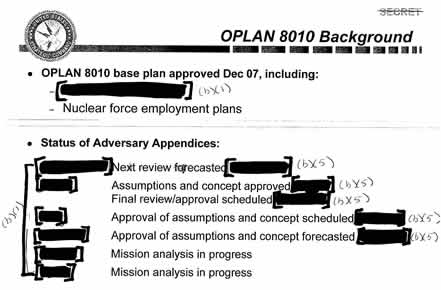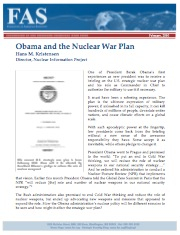 |
| The current U.S. strategic war plan is directed against six adversaries. Guess who. |
.
By Hans M. Kristensen
While the completion of the Obama administration’s Nuclear Posture Review continues to slide, FAS today published an issue paper on how a decision to reduce the role of nuclear weapons might influence the U.S. strategic war plan.
President Obama pledged in his Prague speech last year that he would “reduce the role of nuclear weapons” to “put an end to Cold War thinking,” and reaffirmed earlier this month that the “Nuclear Posture Review will reduce [the] role….”
How to reduce the role in a way that is seen as significant by the global nonproliferation community, visible to adversaries, and compatible with the president’s other pledge to “maintain a safe, secure and effective arsenal to deter any adversary…as long as these weapons exist” apparently is the subject of a heated debate within the administration.
 |
| Click image to download report. |
The most persistent rumor is that the review might remove a requirement to plan nuclear strikes against chemical and biological weapons; reduce the mission to the core role of deterring use of other nuclear weapons. I recently described that the Quadrennial Defense Review stated that new regional deterrence architectures and non-nuclear capabilities “make possible a reduced role for nuclear weapons in our national security strategy.”
A reduction of the mission to only deter nuclear use would roll back much of the expansion of nuclear doctrine that happened during the Clinton and Bush administrations. But it would not “put an end to Cold War thinking,” but to post-Cold War thinking.
To put an end to Cold War thinking, the reduced role would have to affect the core of the war plan that is directed against Russia and China.
The issue paper describes how the strategic war plan is structured, how it has evolved, and discusses options for reducing the mission and the war plan itself.
This publication was made possible by a grant from Carnegie Corporation of New York and Ploughshares Fund. The statements made and views expressed are solely the responsibility of the author.
A military depot in central Belarus has recently been upgraded with additional security perimeters and an access point that indicate it could be intended for housing Russian nuclear warheads for Belarus’ Russia-supplied Iskander missile launchers.
The Indian government announced yesterday that it had conducted the first flight test of its Agni-5 ballistic missile “with Multiple Independently Targetable Re-Entry Vehicle (MIRV) technology.
While many are rightly concerned about Russia’s development of new nuclear-capable systems, fears of substantial nuclear increase may be overblown.
Despite modernization of Russian nuclear forces and warnings about an increase of especially shorter-range non-strategic warheads, we do not yet see such an increase as far as open sources indicate.